Simulation and Analysis of Proppant Transport Patterns in Wellbore-Fracture Systems
Abstract
1. Introduction
2. Simulation Validation
2.1. Equation Used in Simulation
- (1)
- Euler model
- (2)
- Standard k-ε turbulence model
2.2. Validation of Simulation Results against Experimental Results
3. Proppant Transport in The Wellbore
3.1. Methodology: Simulation Modle and Parameter Settings
3.2. Discussion and Conclusions of Simulation Results
3.2.1. Proppant Distribution in The Wellbore
3.2.2. Solid and Liquid Phase Flow Distribution of Each Cluster
4. Wellbore-Complex Fractures Network Proppant Transport
4.1. Geological Parameters Research
4.2. Simulation of Proppant Distribution within Fracture in a General Fractures Network
4.2.1. Methodology: Simulation Modle and Parameter Settings
4.2.2. Discussion and Conclusions of Simulation Results
4.3. Simulation under Different Complex Fractures Network Conditions
4.3.1. Methodology: Parameter Settings
4.3.2. Discussion and Conclusions of Simulation Results
5. Parameter Optimisation Analysis
5.1. Basic Parameter Settings
5.2. Optimization of Pump Displacement
5.3. Optimisation of Fracturing Fluid Viscosity
5.4. Optimisation of Proppant Particle Diameter
5.5. Optimisation of Sand Ratio
5.6. Comparison of the Practical Application of Optimised and Conventional Parameters
6. Conclusions
- (1)
- The simulation results concluded that the sand and fluid inside the horizontal wellbore during fracturing had a variable mass flow pattern with asynchronous distribution, and the proppant accumulation phenomenon inside the wellbore formed by this pattern led to the uneven distribution of proppant inside the fracture. The specific situation is as follows: The distribution of proppant and fluid inside the horizontal wellbore was not synchronized during fracturing, with the liquid phase gradually decreasing from the heel end to the toe end and the solid phase gradually increasing from the heel end to the toe end; the proppant formed deposits on the toe end side of the wellbore, causing poor proppant circulation, resulting in less proppant entering the toe end side of the fracture and more entering the heel end side of the fracture.
- (2)
- The simulation results conclude that the location of the perforation clusters and the number of fracture stages during fracturing have an important influence on the proppant distribution. The specific situation is as follows: During fracturing, the fracture proppant at the heel side of the complex fracture network was higher, and the fracture proppant at the toe end was lower, which is consistent with the findings of the in-bore simulation.
- (3)
- The preferred parameters derived from the simulations have been applied in real-life fracturing projects; it obtained substantially better production rates than the production of those wells, which are constructed with conventional fracturing parameters. Preferred parameters include pumping displacement, fracturing fluid viscosity, proppant particle size and sand ratio. 14 m3/min, 5 mPa·s, 40/170 mesh and 12% sand ratio were identified as the preferred construction parameters.
Author Contributions
Funding
Data Availability Statement
Conflicts of Interest
References
- Zou, C.; Zhu, R.; Wu, S.; Hou, L.; Zhu, R.; Tao, S.; Yuan, X.; Dong, D.; Wang, Y.; Guo, Q.; et al. Characteristics, Mechanism and Prospect of Conventional and Unconventional Oil and Gas Accumulation Types—Taking Tight Oil and Tight Gas in China as Examples. Acta Pet. Sin. 2012, 33, 173–187. [Google Scholar]
- Huang, S.; Ni, J. Particle force in solid-liquid two-phase flow and its influence on vertical separation. J. Hydraul. Eng. 2002, 33, 6–13. [Google Scholar]
- Tang, X.; Xu, Y.; Wu, Y. Dynamic model of turbulent solid-liquid two-phase flow with high concentration. Chin. J. Theor. Appl. Mech. 2002, 34, 956–962. [Google Scholar]
- Bagnold, R.A. Experiments on a gravity-free dispersion of large solid spheres in a Newtonian fluid under shear. Ser. A. Math. Phys. Sci. 1954, 225, 49–63. [Google Scholar]
- Ding, J.; Gidaspow, D. A Bubbling Fluidization Model Using Kinetic Theory of Granular Flow. Aiche J. 1990, 36, 523–538. [Google Scholar] [CrossRef]
- Yue, X.; Kong, L. Basic model of solid particle flow. J. Daqing Pet. Inst. 1995, 1–5. [Google Scholar]
- Louge, M.Y.; Mastorakos, E.; Jenkins, J.T. The Role of Particle Collisions in Pneumatic Transport. J. Fluid Mech. 2006, 231, 345–359. [Google Scholar] [CrossRef]
- He, C. Numerical simulation of power-law fluid spiral flow in concentric annulus. Drill. Fluid Complet. Fluid 2002, 2, 12–14+56. [Google Scholar]
- Fu, X.; Wang, G.; Dong, C. Theoretical analysis of low concentration solid-liquid two-phase flow and numerical calculation of pipe flow. Sci. China 2001, 31, 556–565. [Google Scholar]
- Li, Z.; Wei, J.; Yu, B. Theoretical and numerical analysis of particle force in turbulent flow in sparse gas-solid two-phase channel. J. Univ. Chin. Acad. Sci. 2017, 34, 146–152. [Google Scholar]
- Warpinski, N.R.; Teufel, L.W. Influence of Geologic Discontinuities on Hydraulic Fracture Propagation. Soc. Pet. Eng. 1987, 39, 209–220. [Google Scholar]
- Jiang, T.; Jia, C.; Wang, H.; Xia, S. Study on design method of shale gas network fracturing. Pet. Drill. Technol. 2011, 39, 36–40. [Google Scholar]
- Weng, X.; Kresse, O.; Cohen, C.; Wu, R.; Gu, H. Modeling of hydraulic-fracture-network propagation in a naturally fractured formation. SPE Prod. Oper. 2011, 26, 368–380. [Google Scholar]
- Wu, R.; Kresse, O.; Weng, X.; Cohen, C.; Hu, G. Modeling of interaction of hydraulic fractures in complex fracture networks. In Proceedings of the SPE Hydraulic Fracturing Technology Conference, OnePetro, The Woodlands, TX, USA, 6 February 2012. [Google Scholar]
- Zhang, S.; Guo, T.; Zhou, T.; Yushi, S. Fracture propagation mechanism test of natural shale fracturing. Acta Pet. Sin. 2014, 35, 496–503+518. [Google Scholar]
- Zhao, J.; Li, Y.; Wang, S.; Jiang, Y.; Liehui, Z. Simulation of complex fracturing fracture network under the influence of natural fractures. Nat. Gas Ind. 2014, 34, 68–73. [Google Scholar]
- Liu, H.; Lan, Z.; Wang, S.; Xu, J. Mechanism of hydraulic fracture initiation under fixed-plane perforation of horizontal wells. Pet. Explor. Dev. 2015, 42, 794–800. [Google Scholar] [CrossRef]
- Wang, B.; Li, J.; Liu, G.; Chen, S.; Fu, C.; Zhao, C. Physical simulation of fracture propagation law near wellbore based on staggered fixed plane perforation. Pet. Explor. Dev. 2019, 46, 1187–1196. [Google Scholar] [CrossRef]
- Liu, C. Study on Numerical Simulation and Construction Parameter Optimization of Hydraulic Fracturing in Horizontal Well. Ph.D. Thesis, University of Science and Technology of China, Hefei, China, 2017. [Google Scholar]
- Tian, W. Numerical Simulation of Complex Fracture Network in Hydraulic Fracturing of Shale Reservoir. Ph.D. Thesis, University of Science and Technology of China, Hefei, China, 2018. [Google Scholar]
- Li, L. Experimental Study on Sedimentation and Migration Law of Proppant in Fracture. Ph.D. Thesis, Southwest Petroleum University, Chengdu, China, 2014. [Google Scholar]
- Zhang, Z. Experimental and numerical simulation study on proppant transportation of shale gas slippery water fracturing. Petrochem. Ind. Appl. 2017, 36, 43–46. [Google Scholar]
- Hui, F. Study on the Laying Law of Slippery Water Fracturing Proppant in Fractures. Ph.D. Thesis, Xi’an Shiyou University, Xi’an, China, 2017. [Google Scholar]
- Wen, Q.; Gao, J.; Liu, H.; Huang, K. Dynamic experiment on sand carrying performance of slippery water. Oil Drill. Prod. Technol. 2015, 37, 97–100. [Google Scholar]
- Zhou, D.; Zhang, Z.; Hui, F.; Shi, Y.; Zhao, C.; Zhou, Y. Experiment and numerical simulation of proppant transport law in main fracture of slippery water fracturing. Oil Drill. Prod. Technol. 2017, 39, 499–508. [Google Scholar]
- Zhan, Y.; Luo, M.; Gao, J.; Li, Y. A Proppant Migration Simulation Device with Variable Slot Net Structure. J. Yangtze Univ. 2019, 16, 53–57+96+7. [Google Scholar]
- Zhang, K.; Zhang, T.; Wu, S.; Li, N.; He, S.; Li, J. Simulation of migration law of proppants with different particle sizes in fractures. Reservoir Evaluation and Development. Rsvr. Eval. Develop. 2019, 9, 72–77. [Google Scholar]
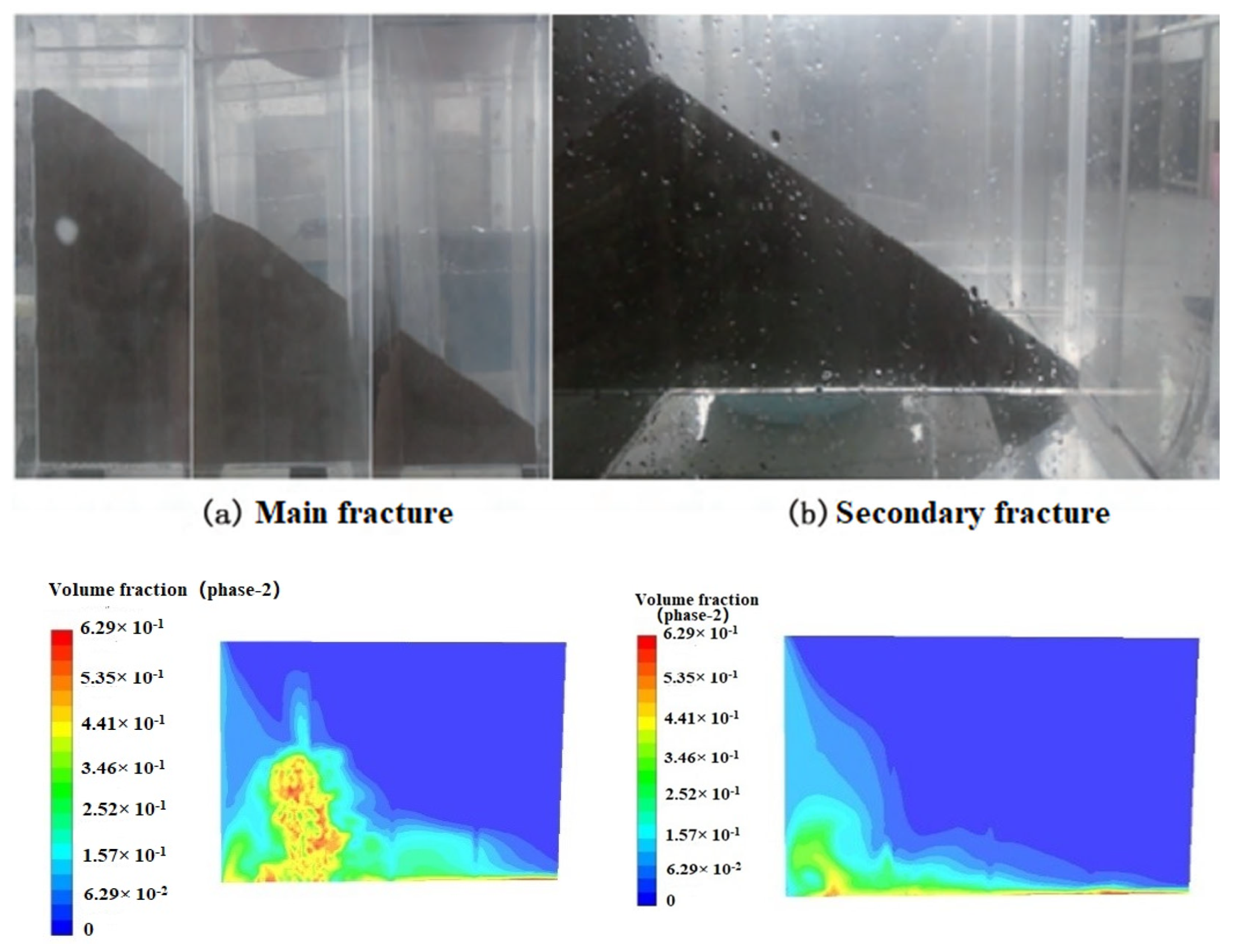
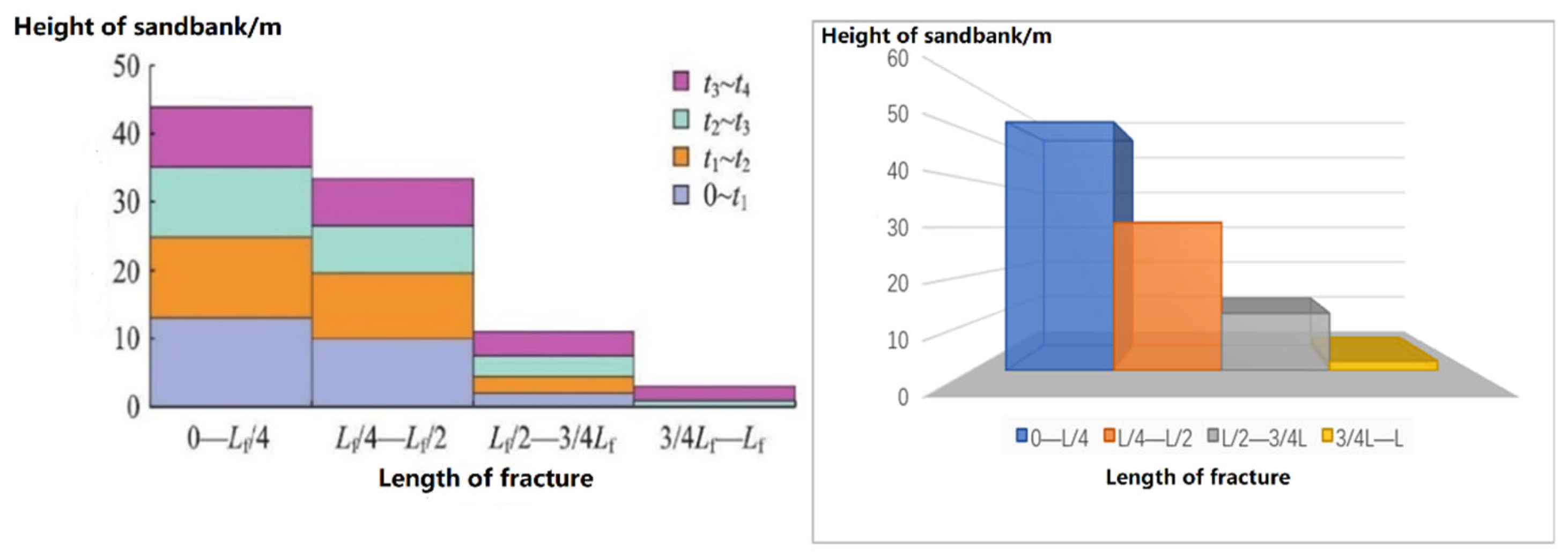
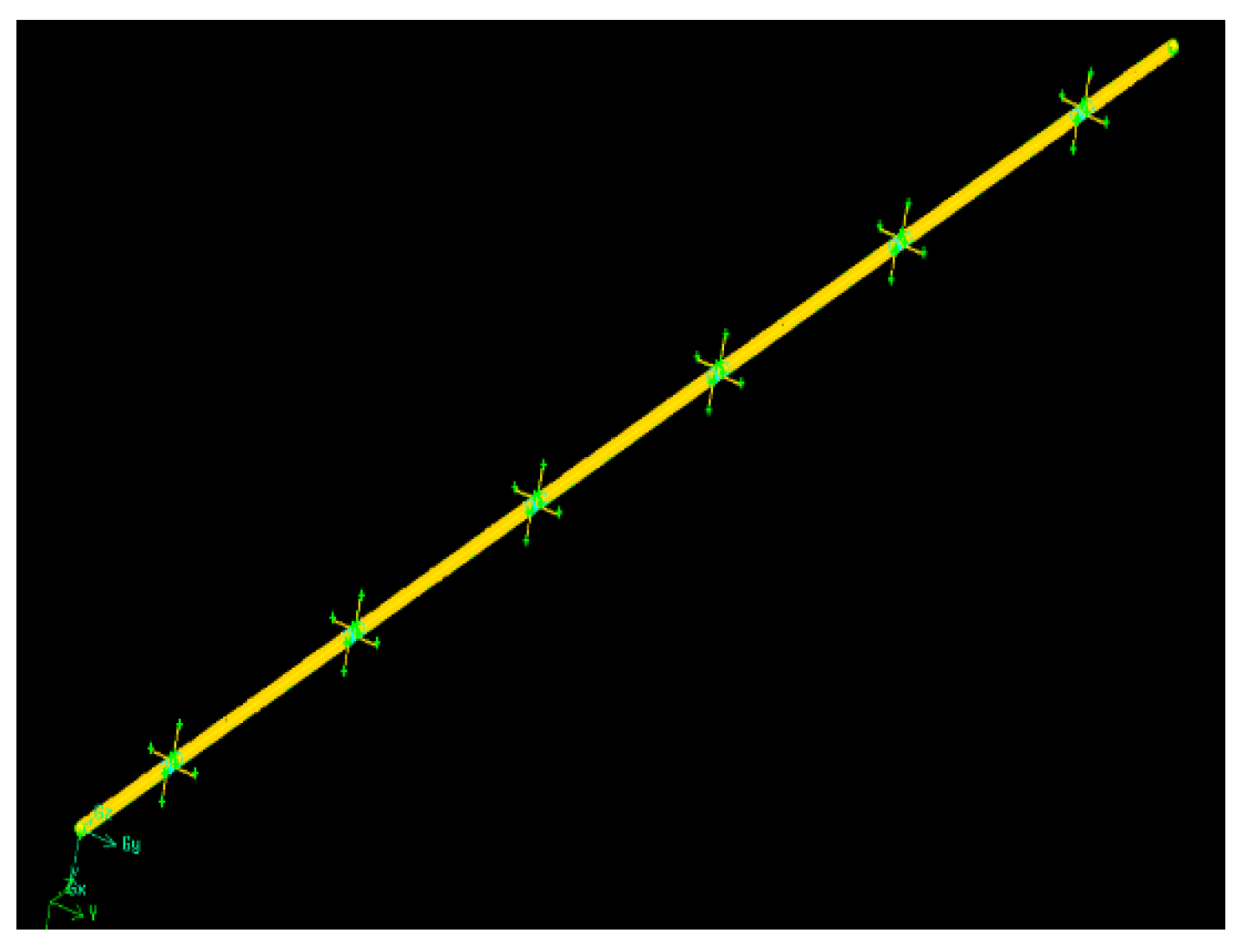

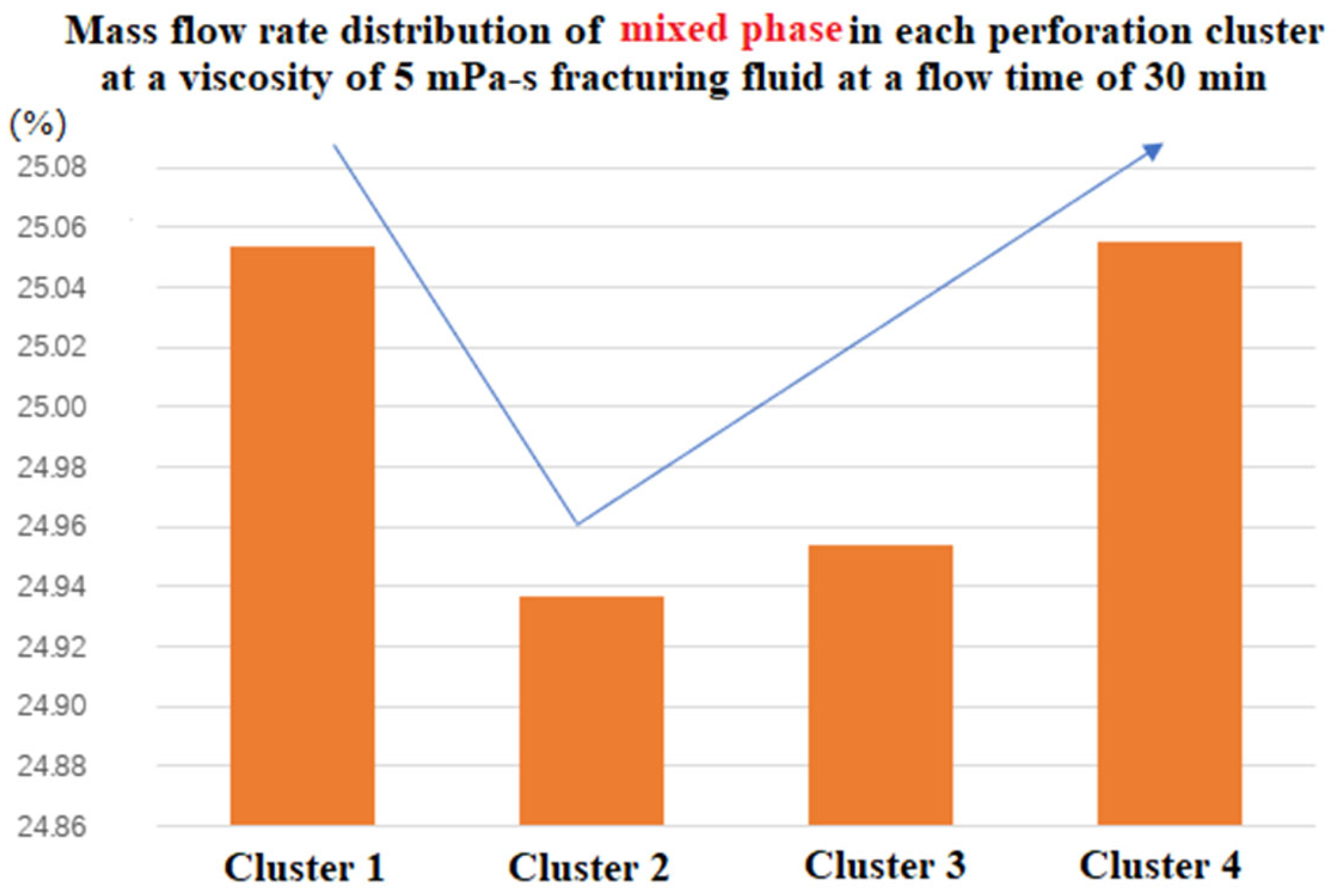

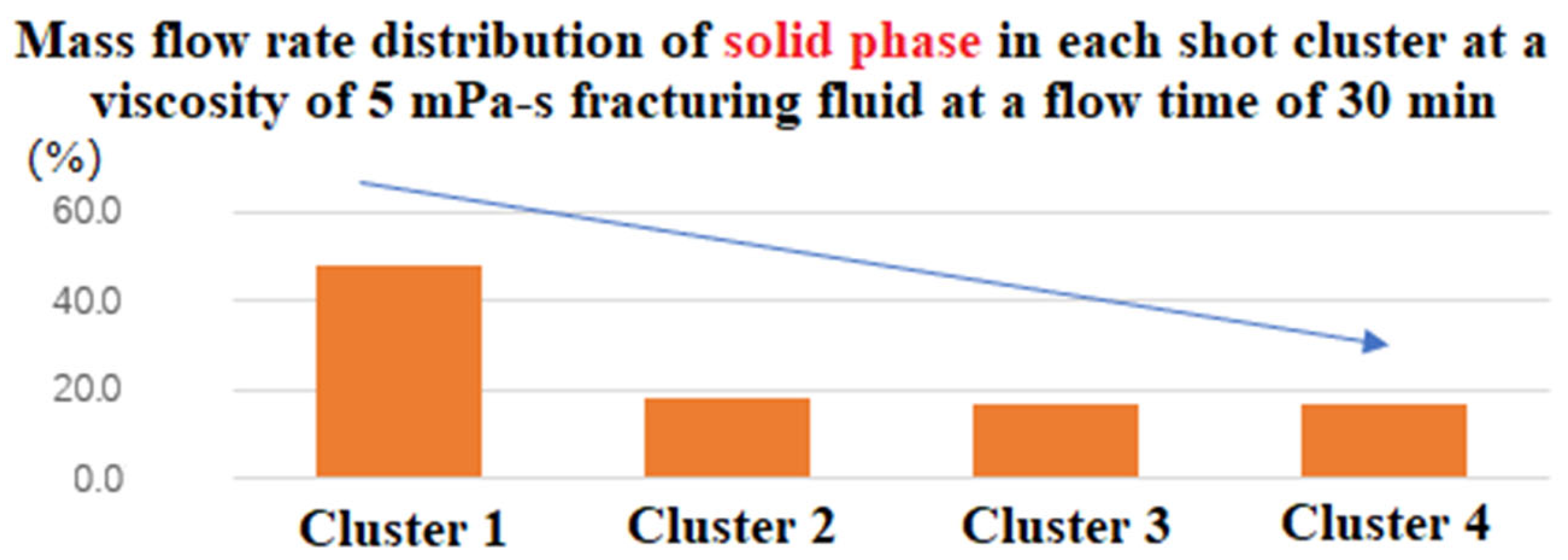

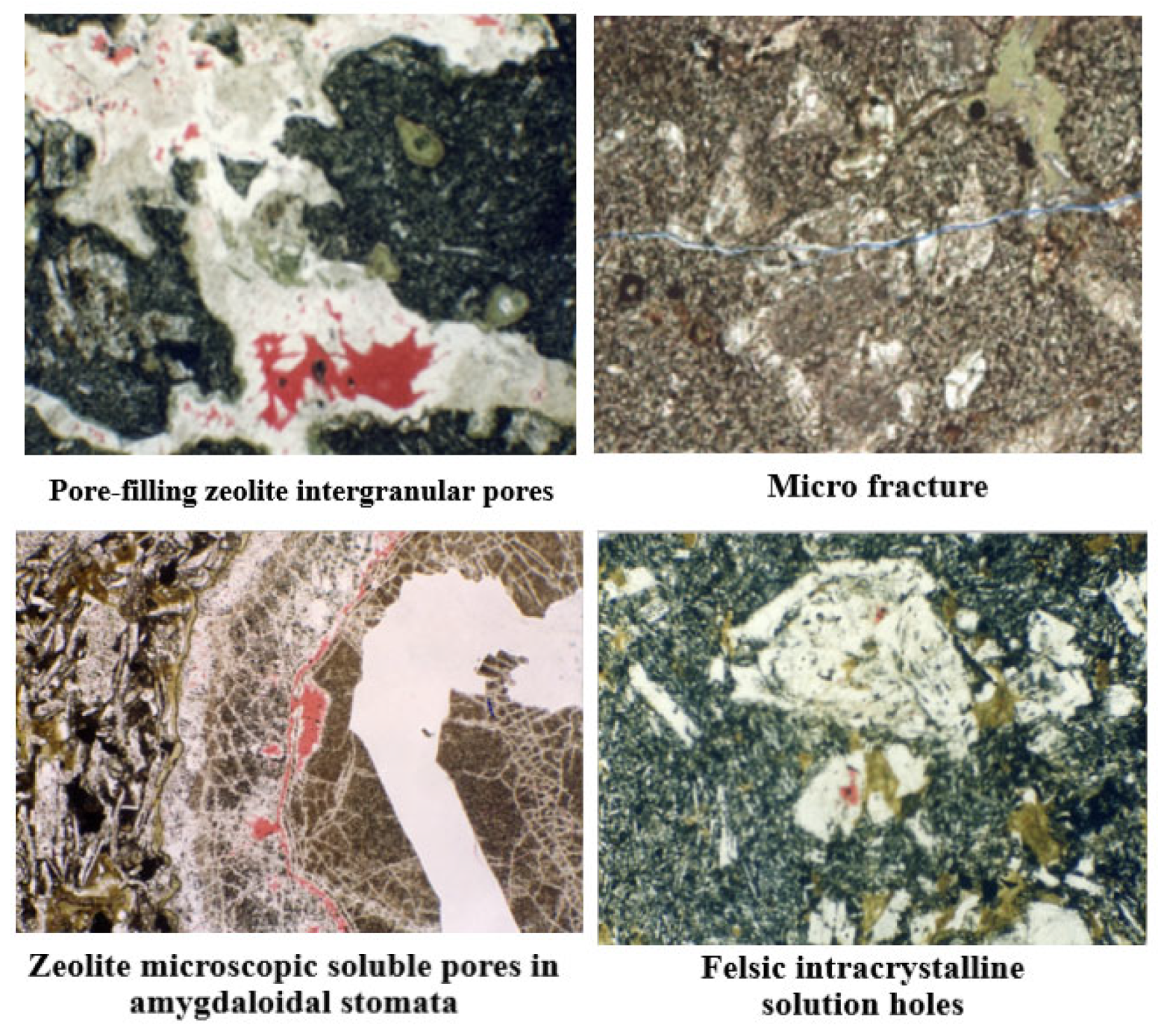

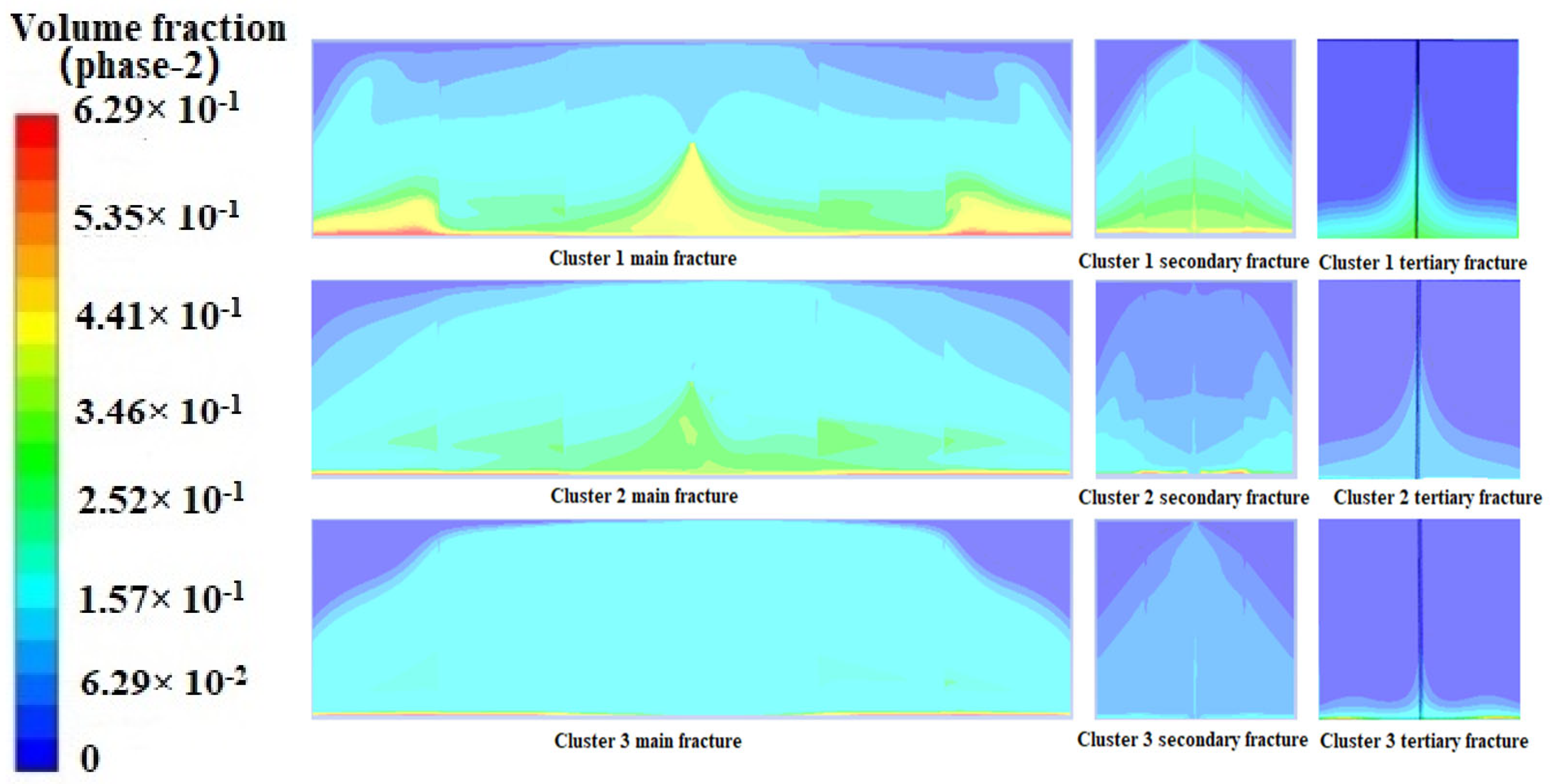

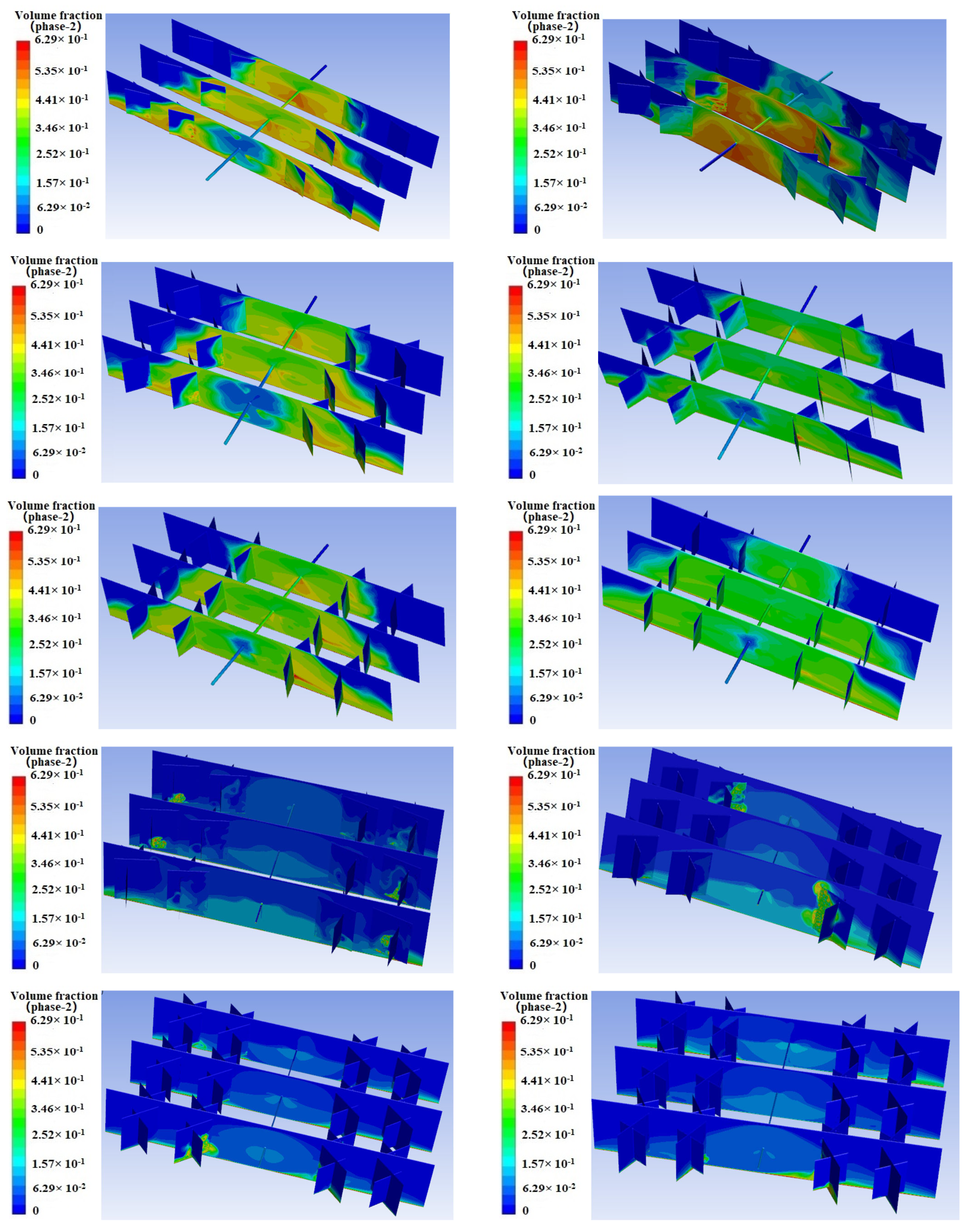
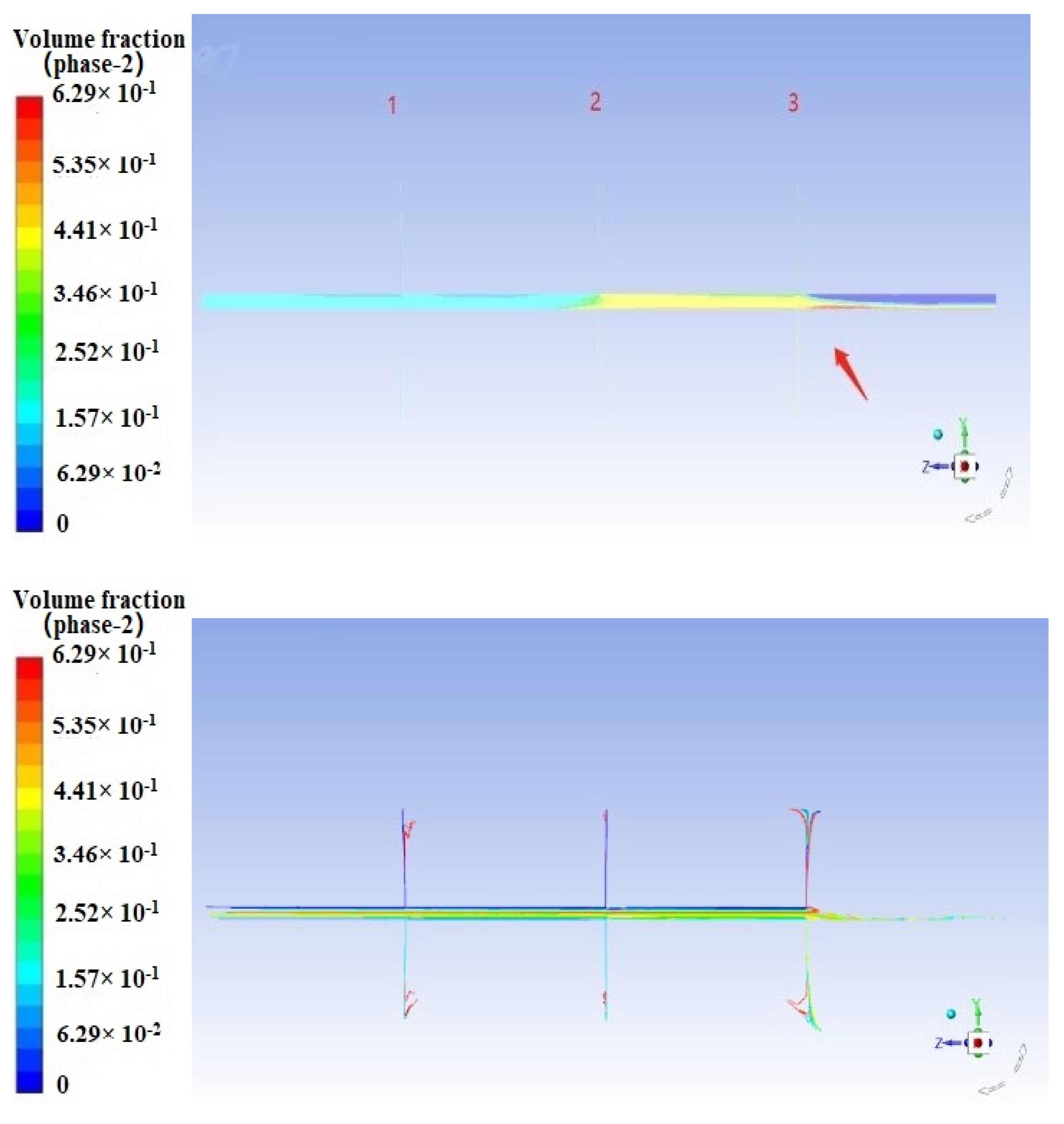
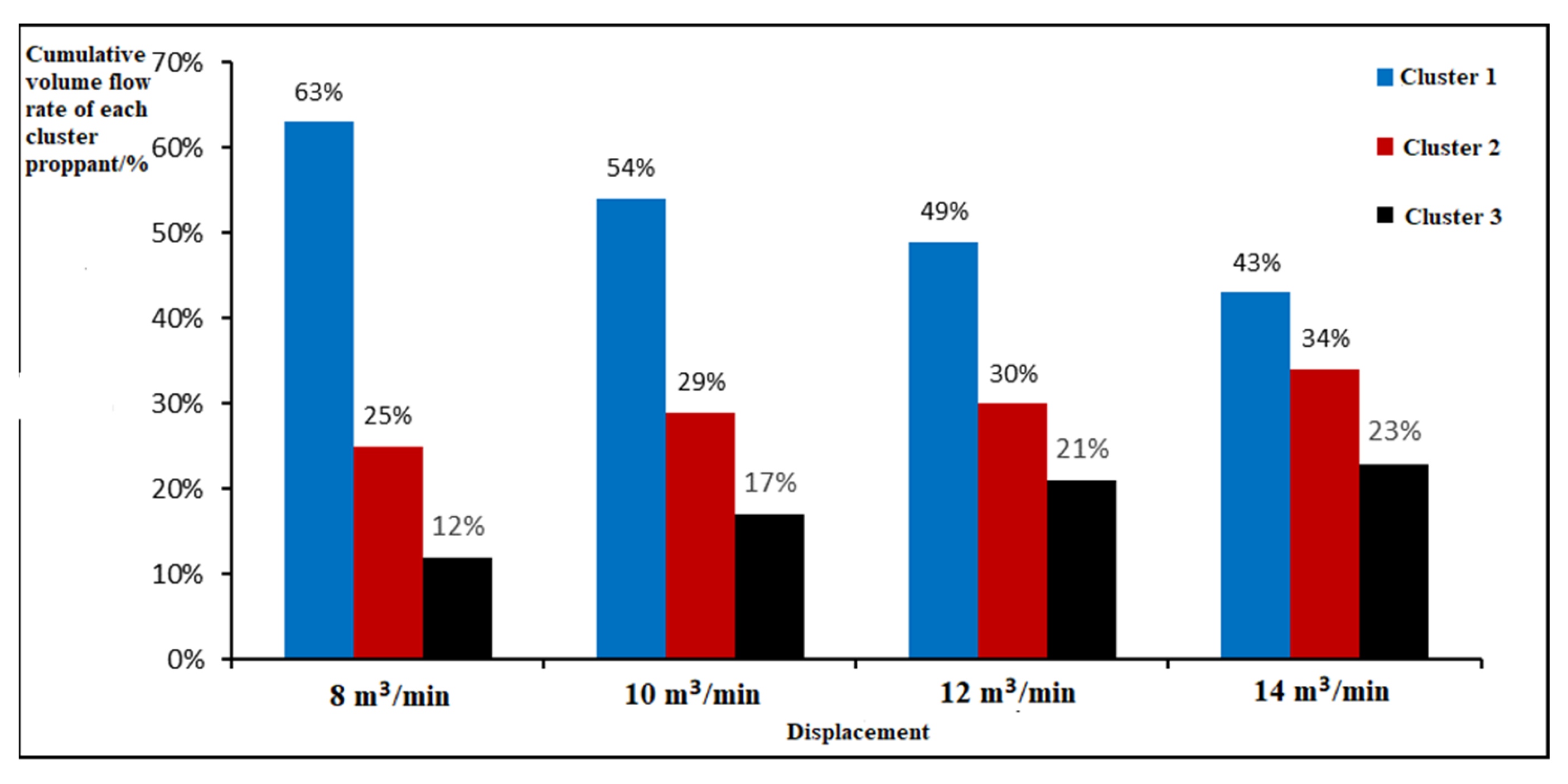


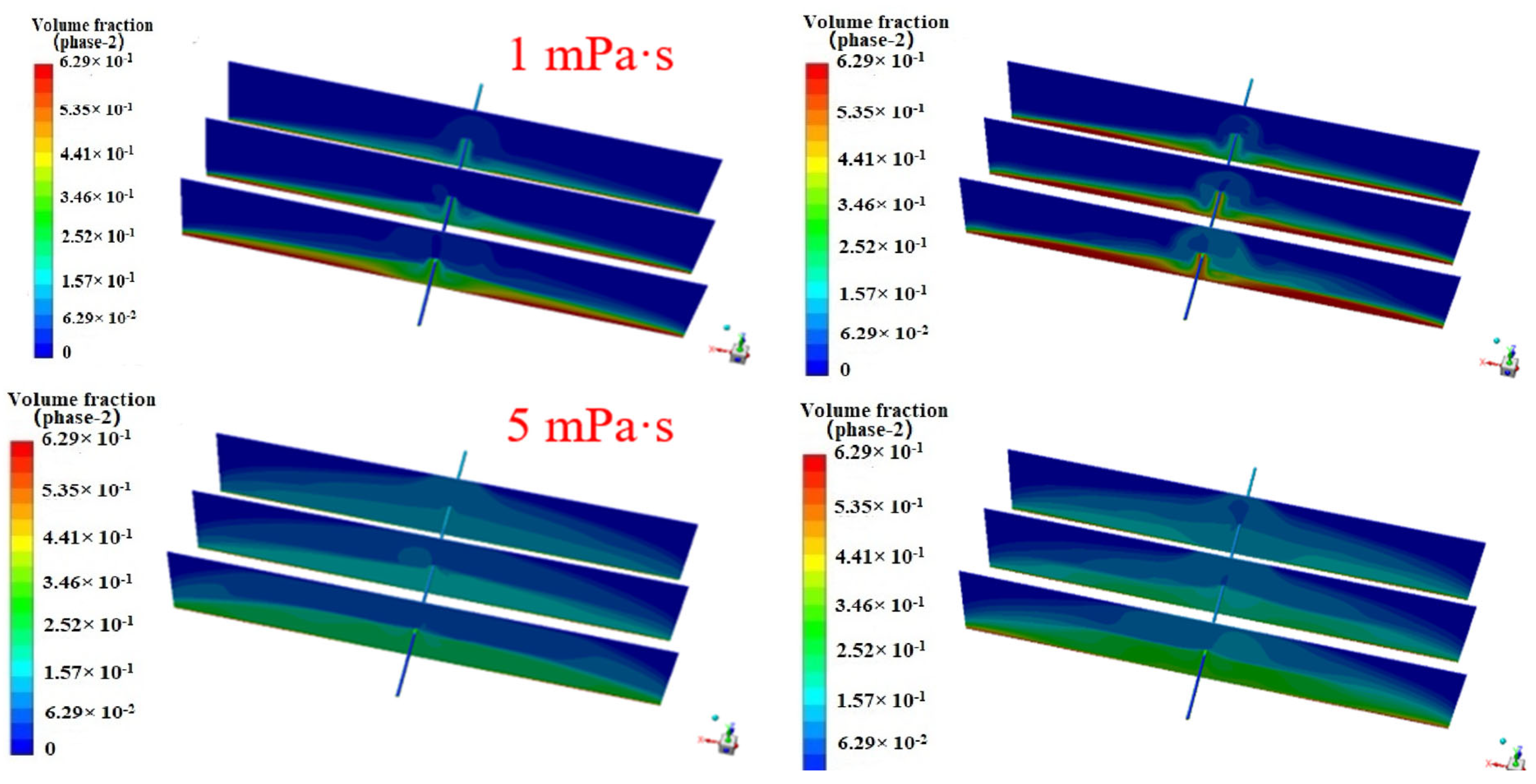
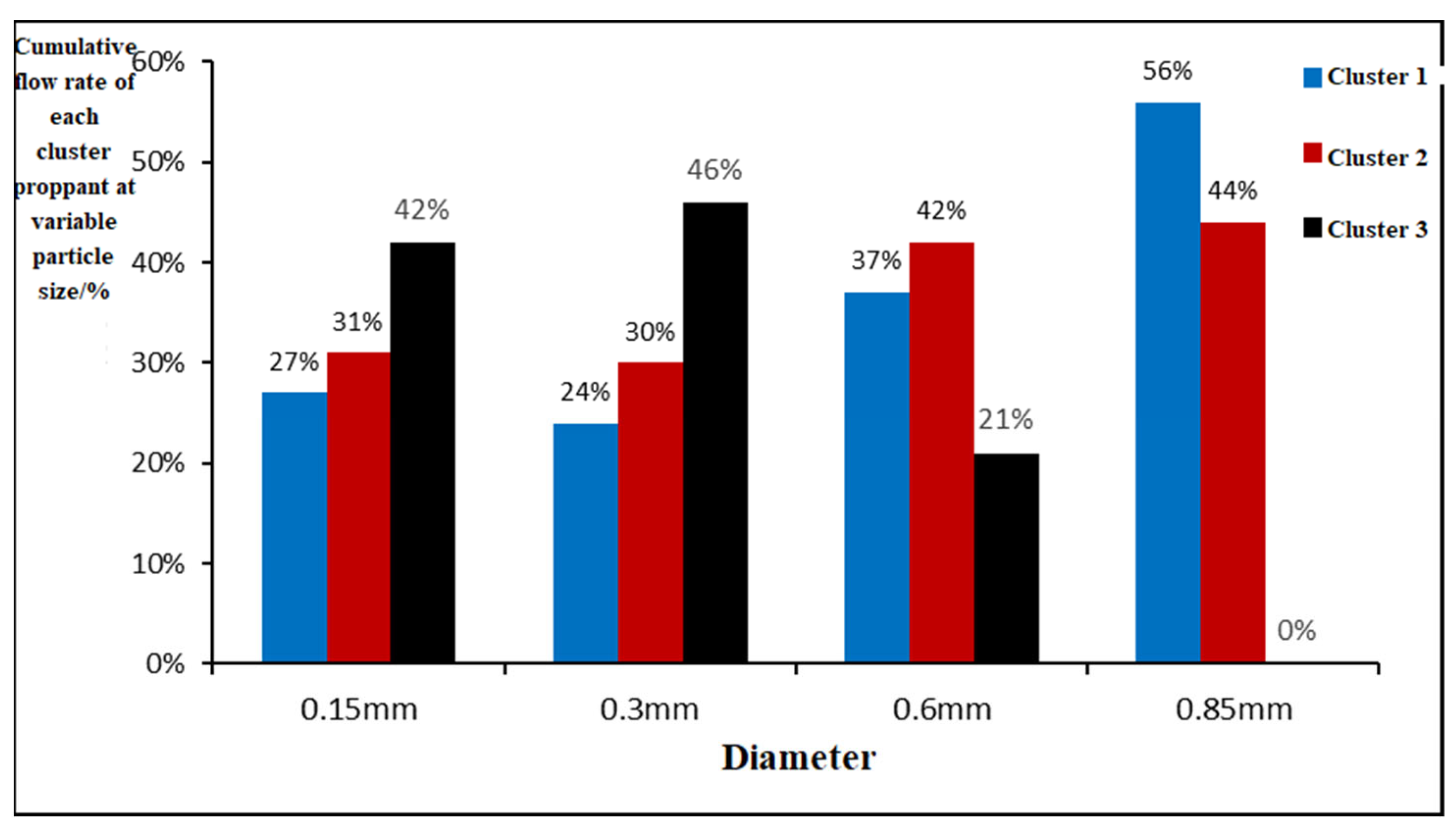
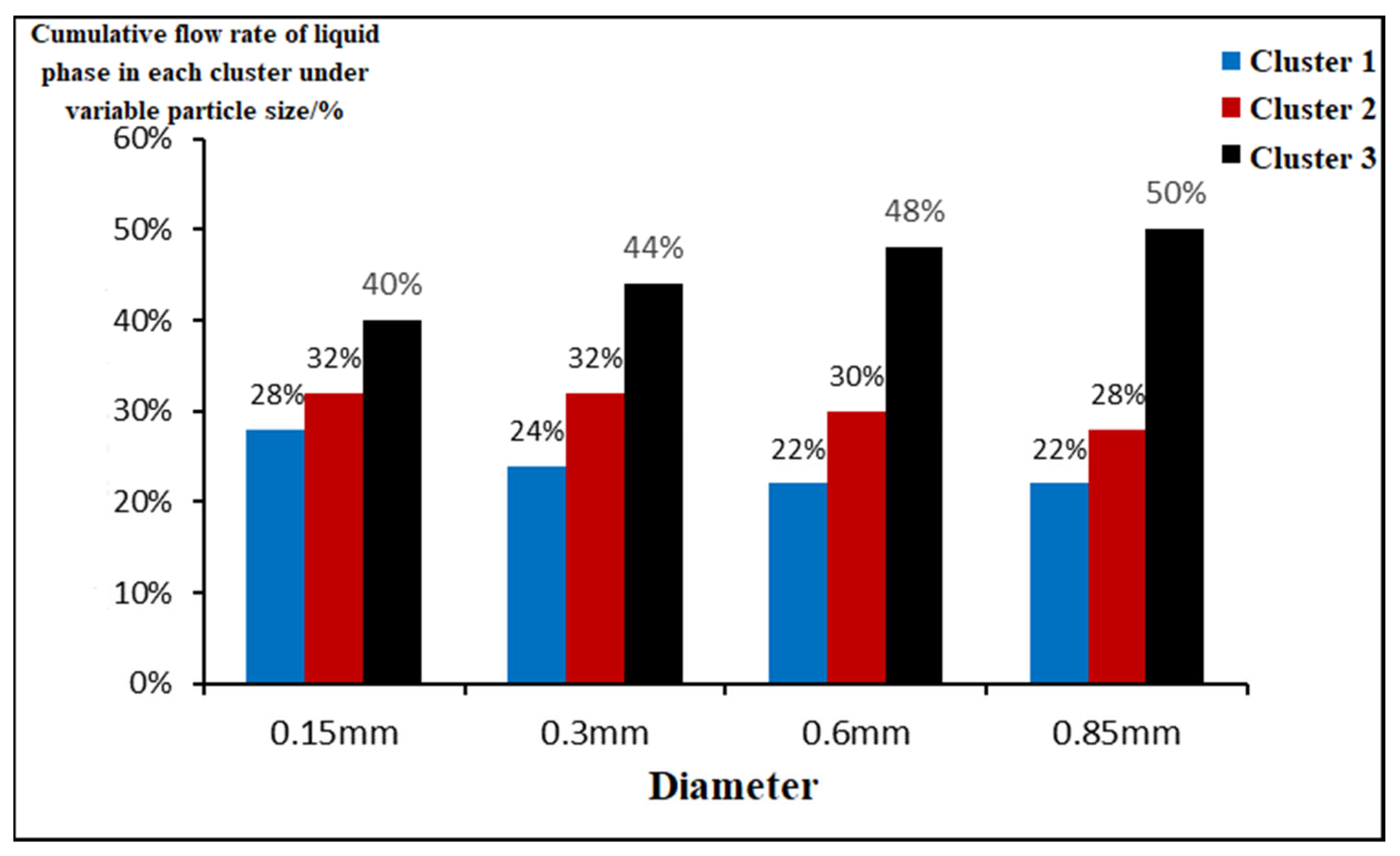
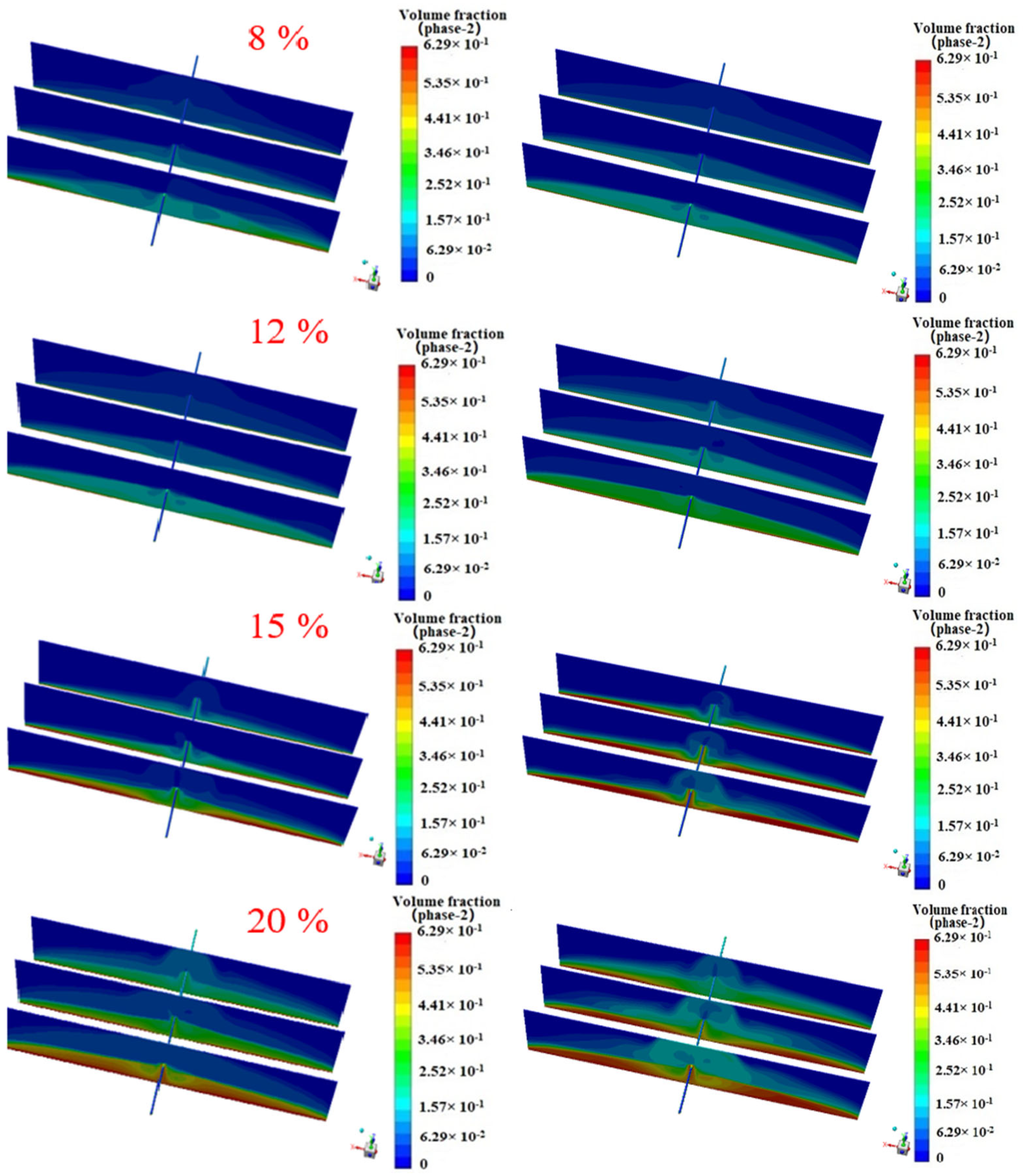
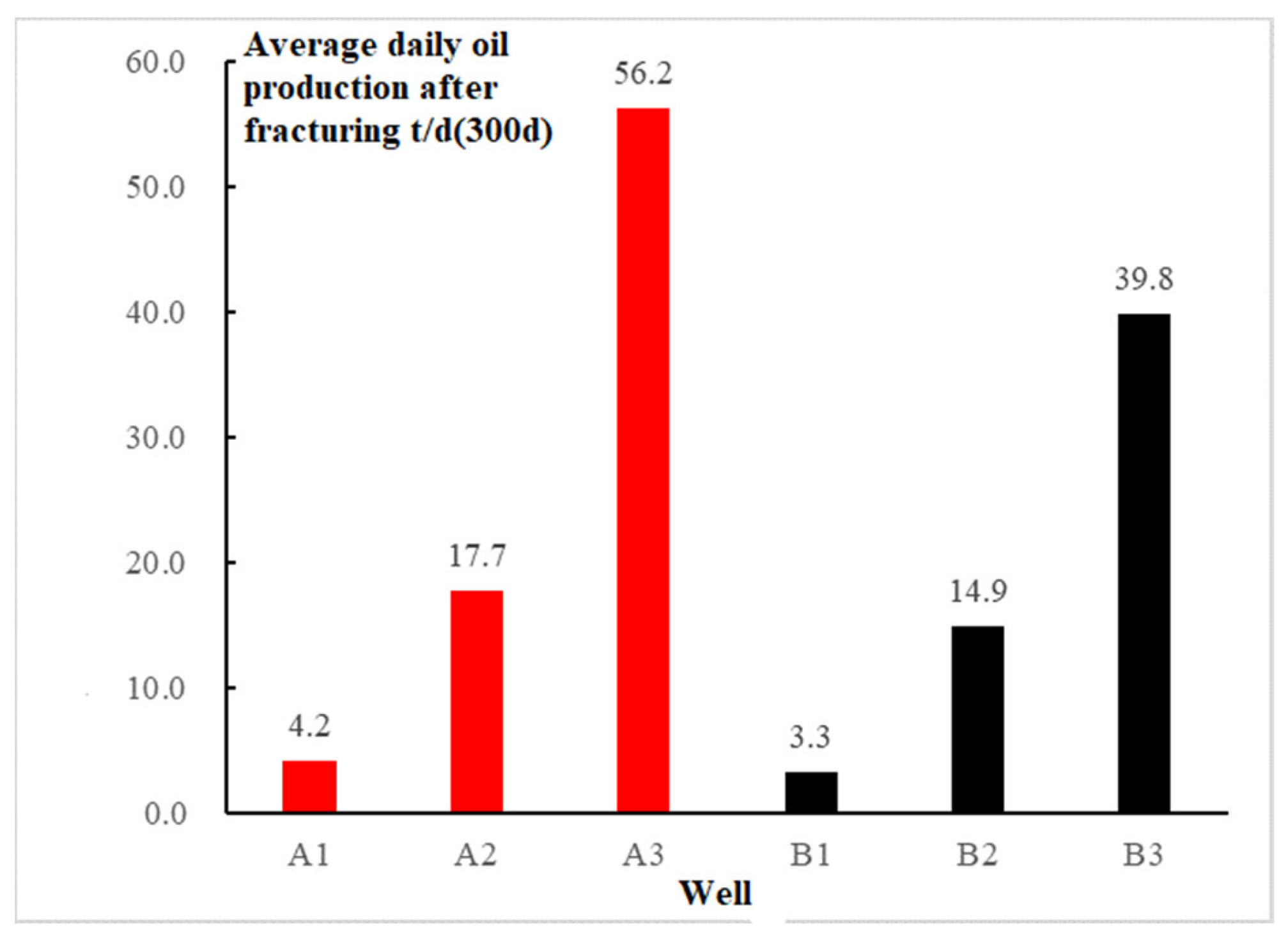
| Parameters | Values | Parameters | Values |
|---|---|---|---|
| Horizontal well section length | 65 m | Diameter of wellbore | 118.62 mm |
| Mass fraction of proppant | 12% | Inlet Displacement | 12 m3/min |
| Fracturing fluid density | 1100 kg/m3 | Proppant diameter | 0.8 mm |
| Fracturing fluid viscosity | 5 mPa·s | Proppant density | 1650 kg/m3 |
| Gravitational acceleration | −9.81 m/s2 | Cluster spacing | 15 m |
| Outlet pressure | 55 MPa | Wall roughness height | 32 μm |
| Perforation diameter | 10 mm | Number of clusters | 6 |
| Parameters | Values | Parameters | Values |
|---|---|---|---|
| Cluster spacing | 20 m | Secondary fracture width | 4 mm |
| Half main fracture length | 90 m | Tertiary seam width | 3 mm |
| Half secondary fracture length | 20 m | Fracture angle | 90° |
| Half tertiary seam length | 20 m | Fracturing fluid viscosity | 5 mPa·s |
| Main fracture width | 6 mm | Displacement | 12 m3/min |
| Main fracture height | 30 m | Diameter of wellbore | 118.62 mm |
| Fracture Level | Stage/Clusters | Cluster Spacing/m | Fractures Angle/° |
|---|---|---|---|
| 2 | 1/3 | 20 | 15 |
| 2 | 1/3 | 20 | 30 |
| 2 | 1/3 | 20 | 45 |
| 2 | 1/3 | 20 | 60 |
| 2 | 1/3 | 20 | 75 |
| 2 | 1/3 | 20 | 90 |
| 3 | 1/3 | 20 | 15/90 |
| 3 | 1/3 | 20 | 30/90 |
| 3 | 1/3 | 20 | 45/90 |
| 3 | 1/3 | 20 | 60/90 |
| Parameters | Values | Parameters | Values |
|---|---|---|---|
| Cluster spacing | 25 m | Outlet pressure | 55 MPa |
| Stage length | 100 m | Fracturing fluid viscosity | 1 mPa·s |
| Half fracture length | 75 m | Displacement | 10 m3/min |
| Fracture height | 25 m | Proppant diameter | 0.3 mm |
| Fracture width | 6 mm | Proppant mass fraction | 12% |
| Well | Displacement (m3/min) | Average Sand Ratio (%) | Total Sand Volume (m3) | Total Liquid Volume (m3) | Sand to Liquid Ratio (%) |
|---|---|---|---|---|---|
| A1 | 12~14 | 11.9 | 1215 | 16,400 | 13.5 |
| A2 | 12~14 | 12 | 1110 | 18,200 | 16.4 |
| A3 | 12~14 | 12.3 | 1780 | 30,100 | 16.9 |
Disclaimer/Publisher’s Note: The statements, opinions and data contained in all publications are solely those of the individual author(s) and contributor(s) and not of MDPI and/or the editor(s). MDPI and/or the editor(s) disclaim responsibility for any injury to people or property resulting from any ideas, methods, instructions or products referred to in the content. |
© 2023 by the authors. Licensee MDPI, Basel, Switzerland. This article is an open access article distributed under the terms and conditions of the Creative Commons Attribution (CC BY) license (https://creativecommons.org/licenses/by/4.0/).
Share and Cite
Zhang, J.; Li, Y.; Yang, H.; Guo, X. Simulation and Analysis of Proppant Transport Patterns in Wellbore-Fracture Systems. Energies 2023, 16, 4421. https://doi.org/10.3390/en16114421
Zhang J, Li Y, Yang H, Guo X. Simulation and Analysis of Proppant Transport Patterns in Wellbore-Fracture Systems. Energies. 2023; 16(11):4421. https://doi.org/10.3390/en16114421
Chicago/Turabian StyleZhang, Jingchen, Yan Li, Huilu Yang, and Xiaodong Guo. 2023. "Simulation and Analysis of Proppant Transport Patterns in Wellbore-Fracture Systems" Energies 16, no. 11: 4421. https://doi.org/10.3390/en16114421
APA StyleZhang, J., Li, Y., Yang, H., & Guo, X. (2023). Simulation and Analysis of Proppant Transport Patterns in Wellbore-Fracture Systems. Energies, 16(11), 4421. https://doi.org/10.3390/en16114421





